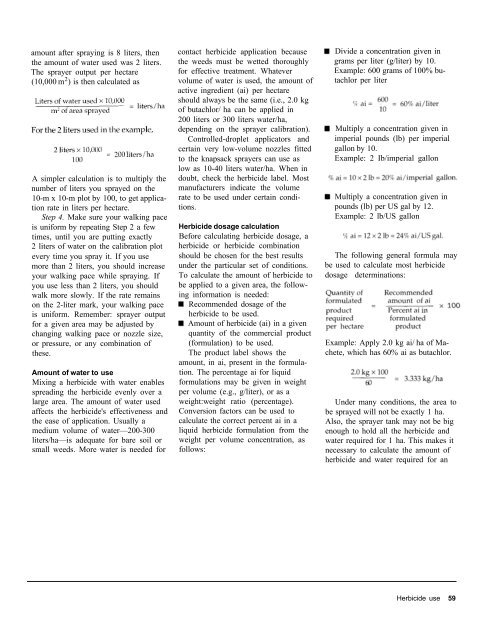A handbbok on Weed Control in Rice.pdf
A handbbok on Weed Control in Rice.pdf
A handbbok on Weed Control in Rice.pdf
You also want an ePaper? Increase the reach of your titles
YUMPU automatically turns print PDFs into web optimized ePapers that Google loves.
amount after spray<strong>in</strong>g is 8 liters, then<br />
the amount of water used was 2 liters.<br />
The sprayer output per hectare<br />
(10,000 m 2 ) is then calculated as<br />
A simpler calculati<strong>on</strong> is to multiply the<br />
number of liters you sprayed <strong>on</strong> the<br />
10-m x 10-m plot by 100, to get applica-<br />
ti<strong>on</strong> rate <strong>in</strong> liters per hectare.<br />
Step 4. Make sure your walk<strong>in</strong>g pace<br />
is uniform by repeat<strong>in</strong>g Step 2 a few<br />
times, until you are putt<strong>in</strong>g exactly<br />
2 liters of water <strong>on</strong> the calibrati<strong>on</strong> plot<br />
every time you spray it. If you use<br />
more than 2 liters, you should <strong>in</strong>crease<br />
your walk<strong>in</strong>g pace while spray<strong>in</strong>g. If<br />
you use less than 2 liters, you should<br />
walk more slowly. If the rate rema<strong>in</strong>s<br />
<strong>on</strong> the 2-liter mark, your walk<strong>in</strong>g pace<br />
is uniform. Remember: sprayer output<br />
for a given area may be adjusted by<br />
chang<strong>in</strong>g walk<strong>in</strong>g pace or nozzle size,<br />
or pressure, or any comb<strong>in</strong>ati<strong>on</strong> of<br />
these.<br />
Amount of water to use<br />
Mix<strong>in</strong>g a herbicide with water enables<br />
spread<strong>in</strong>g the herbicide evenly over a<br />
large area. The amount of water used<br />
affects the herbicide's effectiveness and<br />
the ease of applicati<strong>on</strong>. Usually a<br />
medium volume of water—200-300<br />
liters/ha—is adequate for bare soil or<br />
small weeds. More water is needed for<br />
c<strong>on</strong>tact herbicide applicati<strong>on</strong> because<br />
the weeds must be wetted thoroughly<br />
for effective treatment. Whatever<br />
volume of water is used, the amount of<br />
active <strong>in</strong>gredient (ai) per hectare<br />
should always be the same (i.e., 2.0 kg<br />
of butachlor/ ha can be applied <strong>in</strong><br />
200 liters or 300 liters water/ha,<br />
depend<strong>in</strong>g <strong>on</strong> the sprayer calibrati<strong>on</strong>).<br />
C<strong>on</strong>trolled-droplet applicators and<br />
certa<strong>in</strong> very low-volume nozzles fitted<br />
to the knapsack sprayers can use as<br />
low as 10-40 liters water/ha. When <strong>in</strong><br />
doubt, check the herbicide label. Most<br />
manufacturers <strong>in</strong>dicate the volume<br />
rate to be used under certa<strong>in</strong> c<strong>on</strong>di-<br />
ti<strong>on</strong>s.<br />
Herbicide dosage calculati<strong>on</strong><br />
Before calculat<strong>in</strong>g herbicide dosage, a<br />
herbicide or herbicide comb<strong>in</strong>ati<strong>on</strong><br />
should be chosen for the best results<br />
under the particular set of c<strong>on</strong>diti<strong>on</strong>s.<br />
To calculate the amount of herbicide to<br />
be applied to a given area, the follow-<br />
<strong>in</strong>g <strong>in</strong>formati<strong>on</strong> is needed:<br />
Recommended dosage of the<br />
herbicide to be used.<br />
Amount of herbicide (ai) <strong>in</strong> a given<br />
quantity of the commercial product<br />
(formulati<strong>on</strong>) to be used.<br />
The product label shows the<br />
amount, <strong>in</strong> ai, present <strong>in</strong> the formula-<br />
ti<strong>on</strong>. The percentage ai for liquid<br />
formulati<strong>on</strong>s may be given <strong>in</strong> weight<br />
per volume (e.g., g/liter), or as a<br />
weight:weight ratio (percentage).<br />
C<strong>on</strong>versi<strong>on</strong> factors can be used to<br />
calculate the correct percent ai <strong>in</strong> a<br />
liquid herbicide formulati<strong>on</strong> from the<br />
weight per volume c<strong>on</strong>centrati<strong>on</strong>, as<br />
follows:<br />
Divide a c<strong>on</strong>centrati<strong>on</strong> given <strong>in</strong><br />
grams per liter (g/liter) by 10.<br />
Example: 600 grams of 100% bu-<br />
tachlor per liter<br />
Multiply a c<strong>on</strong>centrati<strong>on</strong> given <strong>in</strong><br />
imperial pounds (lb) per imperial<br />
gall<strong>on</strong> by 10.<br />
Example: 2 Ib/imperial gall<strong>on</strong><br />
Multiply a c<strong>on</strong>centrati<strong>on</strong> given <strong>in</strong><br />
pounds (lb) per US gal by 12.<br />
Example: 2 lb/US gall<strong>on</strong><br />
The follow<strong>in</strong>g general formula may<br />
be used to calculate most herbicide<br />
dosage determ<strong>in</strong>ati<strong>on</strong>s:<br />
Example: Apply 2.0 kg ai/ ha of Ma-<br />
chete, which has 60% ai as butachlor.<br />
Under many c<strong>on</strong>diti<strong>on</strong>s, the area to<br />
be sprayed will not be exactly 1 ha.<br />
Also, the sprayer tank may not be big<br />
enough to hold all the herbicide and<br />
water required for 1 ha. This makes it<br />
necessary to calculate the amount of<br />
herbicide and water required for an<br />
Herbicide use 59











